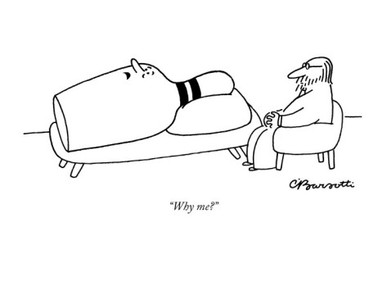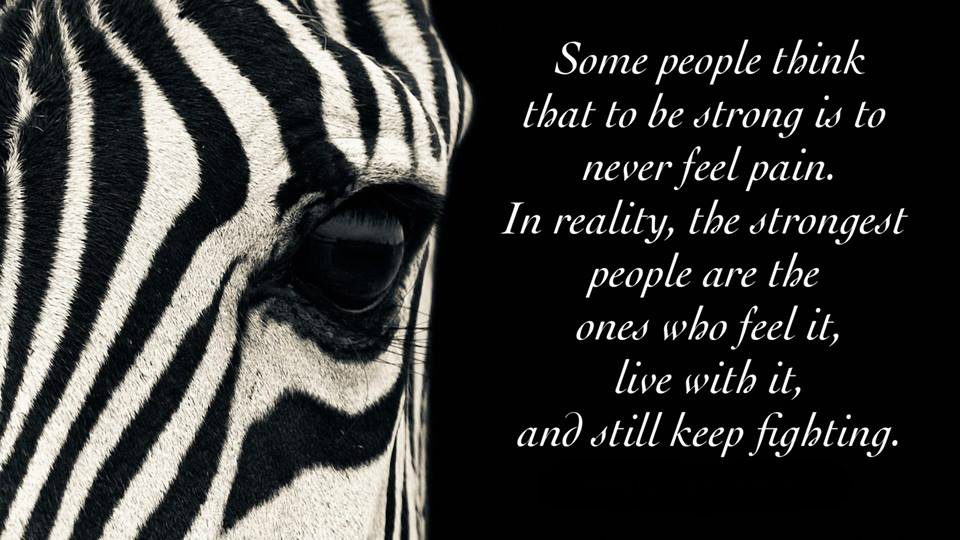 It is the phrase that all of us with chronic illnesses want to shout, scream, and cry. "Why me?" "Why did this happen to me?" More than once I have been guilty of yelling it at the stars, as if they would rearrange to give me a good answer. Unfortunately, I still don't have one. But I have decided that having hours, or sometimes a day or two, of being in the "why me" mode is OK. Being diagnosed with a chronic illness, especially one that is progressive, is a huge change for anyone. I went from being a marathon runner to a slow walker (and some days a non-walker), and from being "top of the class" intelligent to a person with massive brain fog, memory issues, and other cognitive problems. So, yes, the "why me" days are inevitable. They will happen, and when then do, relish in them briefly.
I say briefly, because the problem with the "why me" mindset is that it tends to linger and we begin to wallow in it. The longer we feel sorry for ourselves, the harder it is to break that thought cycle. I now put a time limit on my wallowing. If I feel like absolute crap one day, well, then I have that day to curse and moan at the world. However, I need to start looking on the bright side of things by that evening or the next morning by the very latest. (There are some exceptions to this rule--like the time I had a chest tube for three days. I cursed the world the entire time and I would do the same again.) I feel like this outlook keeps me sane and optimistic, regardless of what I'm up against. Symptom and joint mobility progression in the joint hypermobility syndrome (Ehlers-Danlos syndrome, hypermobility type).
Abstract OBJECTIVES: To evaluate progression of symptoms and joint mobility in the joint hypermobility syndrome (JHS) in order to identify specific disease pictures by age at presentation. METHODS: Fifty JHS patients (44 females, 6 males) were evaluated by Beighton score (BS) calculation, and presence/absence and age at onset of 20 key symptoms. Incidence and prevalence rates by age at onset and sex were calculated and compared by chi-square, Fisher's exact test and Mann-Whitney U-test. Relationship between BS and age at examination was evaluated by the Spearman rho correlation. The existence of an age cut-off separating patients with or without a positive BS was analysed by the receiver operating characteristic analysis. Influence of age on the single components of the BS was also investigated. RESULTS: Except for isolated features, the overall clinical presentation was the same between sexes. In the whole sample, statistically significant differences by age at presentation were registered for fatigue, myalgias, muscle cramps, strains/sprains, dislocations, tendon ruptures, tendonitis, gastroesophageal reflux, chronic gastritis, constipation/diarrhoea and abdominal hernias. A clear inverse correlation between age at examination and BS was demonstrated with an age cut-off fixed at 33 years. Among the components of the BS, spine and elbow joints were not significantly influenced by age. CONCLUSIONS: This study confirmed the existence of a protean clinical history of JHS which may be exemplified in different phases with distinguishable presentations. The knowledge of the peculiarities of each of them will help the practitioner in recognising and, hopefully, treating this condition. PubMed info here. Re-posting this article from XOJane because it is so amazing. I hope you enjoy it as much as I do.
"It happened to me."  I've mentioned previously that I used to power walk through life. I considered myself a city walker, zipping from here to there, quietly muttering at tourists under my breath as I swiftly scurried around them. Now, my walk has no zip. I more so gimp around my neighborhood, and watch as people three times my age easily leave me in their dust. I don't mind the slowness of my gait so much as strangers' reactions to it. More than once, I've been told (usually by older men) to "get out of the way," "quit goofing around" and "stop playing around with your gadgets." I might add here, in none of these cases did I have a Bluetooth or a cellphone on me. Once, I ended up entering the same store as one of the men. I (nicely) told him that I am not "goofing around," but that I walk slowly due to pain and disability. He turned a shade a light tomato, but I'm not sure if he believed me. In all, these situations leave me angry and frustrated. I never know what to do. I feel like ignoring the offender leaves them off the hook too easily and allows them to think that their behavior is OK, but I don't want to have to confront and try to educate every rude person. What is your method of handing these types of situations? Leave your ideas and suggestions in the comment section!
Impairment and impact of pain in female patients with Ehlers-Danlos syndrome: a comparative study with fibromyalgia and rheumatoid arthritis.
Abstract:Objective: The purpose of this study was to investigate functional impairment and the impact of pain in patients with Ehlers-Danlos syndrome, hypermobility type (EDS-HT), and to compare the burden of disease with that in women with fibromyalgia (FM) and rheumatoid arthritis (RA). Results: The study results showed clinically relevant health-related dysfunction in all groups. Significantly poorer physical, psychosocial, and overall function was found in the EDS-HT group compared with the RA group. In comparison with the FM group, the EDS-HT group reported similar physical and overall function, but better psychosocial function. T scores from the MPI revealed significantly higher levels of pain severity and life interference due to pain, and a lower level of perceived life control, in the EDS-HT group compared to the RA group. In contrast, the EDS-HT group showed significantly lower levels of pain severity, life interference, and affective distress in comparison with the FM group. Social support for help in coping with pain was similar between the 3 groups. Conclusion: EDS-HT is associated with a consistent burden of disease, similar to that of FM and worse than that of RA, as well as a broad impact of chronic pain on daily life, which needs to be addressed in the health care system. Full text here.  I spend hours on the phone each week fighting with people in order to coordinate and pay for my care. By "people" I mean the poor souls who have the answer the customer line at my insurance company, and my doctors' offices, and the place that takes my blood, and the hospital, and the testing facility...the list goes on. And by "fighting", I mean that I'm too nice, so I really spend hours on the phone each week politely explaining my case to try to make people care about my plight and then do their jobs.
Sometimes my problem is resolved with a phone call. However, usually it drags on and on--multiple long calls are needed, sometimes letters need to be drafted and sent, I even have made personal visits to billing offices to clear up issues (I'm sure they loved that). I noticed that the reason my problems take months to be solved is that they get passed from office to office. No one wants to deal with a problem, especially when I might just give up and pay them. This summer, I had a few x-rays done of my neck by order of one of my physicians. I got the x-rays at the same hospitals where that physician practices. Both the hospitals and the physician were covered by my insurance; however, my insurance refused payment because my "preventative schedule" did not cover the x-rays. I discovered (after calls to my insurance) that the x-rays should have been billed at diagnostic, not preventative. Somewhere along the way, the billing code was incorrectly changed. After approximately 3 dozen calls to the various parties, I still don't know how the mistake was made or who made it, but it was mysteriously fixed and my insurance paid. I think billing and insurance issues happens to those with chronic illnesses on a regular basis. Mainly because we require more care, but I also sometimes wonder if a handful of others try to take advantage of us. I believe there is always that chance when an ill or disadvantaged individual is involved. My advice to you is to always double check you EOBs and bills: do they match? Also, actually read your EOBs and check the codes at the bottom. Is your insurance covering all that it should be covering? If there is an odd code, don't hesitate to call your insurance to ask about it. Also, find out if your doctor can re-write a prescription/order so that it can be covered. If you are having a problem with your doctor's office, speak to the billing department, and don't be afraid to ask for the office manager. Dysphagia in patients with the joint hypermobility syndrome
Abstract:Results: 17 patients with JHS and dysphagia were referred by the rheumatologists to our unit in 1 year: 76% female; age range: 12–58. None had evidence of a structural cause for the dysphagia on either gastroscopy or barium studies. 10 (59%) had an oesophageal dysmotility to account for their dysphagia – out of these one had achalasia; the other 9 (53%) had oesophageal hypomotility with 7 having frequent hypotensive peristalsis and 2 having intermittent hypotensive peristalsis. 33% of those with hypomotility had a normal Multiple Rapid Swallow test (MRS). 7 of the 17 patients (41%) had normal oesophageal motility and 6 of these had reflux studies: 50% had GOR, 17% had a hypersensitive oesophagus and the remaining 33% had normal studies. Only 2 patients (12%) had hiatus hernias and both of these had oesophageal hypomotility and no GOR. Conclusion: This is the first study of upper GI physiology in patients with JHS and non-structural dysphagia. Oesophageal hypomotility is common in these patients and those patients with normal MRS are likely to show the best response to prokinetics. 50% of those with normal motility had pathological GOR and would benefit from high dose proton pump inhibitor therapy. The remainder had normal studies, suggesting hypersensitivity which may respond to treatment with neuromodulators such as amitriptyline. Only 12% of patients had a hiatus hernia, which is in contrast to previous studies.3 Further prospective studies are required to understand the pathophysiology and management options for dysphagia in JHS. Text here.  In the blink of an eye, you life can change due to a diagnosis of a chronic, incurable disorder. You are forced to come to a screeching halt before taking a sharp turn. Your goals, dreams, and priorities must change. You may grieve and feel the loss of your former self; however, you become grateful for the little things in life--the things that seemed too trivial to notice previously . Worrying about life's minutiae suddenly takes up less of your time. You must now determine how to use each and every ounce of energy, and make it count. Your energy must be spent on people and things that are meaningful to you. Needless drama is cut out of your life. This new life can be confining in ways, but also liberating. Live it.
|


 RSS Feed
RSS Feed